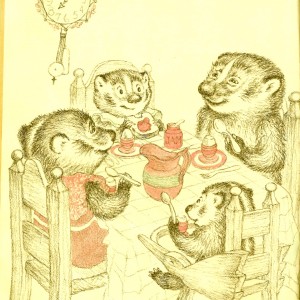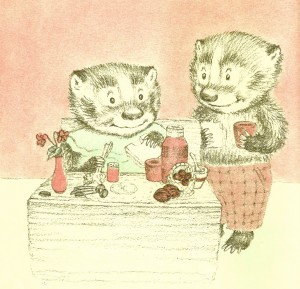Best book ever for picky eaters and their parents: Bread & Jam for Frances

If you are the parent of a picky eater and haven’t read Bread and Jam for Frances, I would rush right out and get a copy.
In the 1964 children’s classic by Russell Hoban, Frances, a little badger, wanders into the picky zone, but only temporarily. How, within two days, she escapes her rut of eating nothing but bread and jam is an inspiring tale full of lessons for parents and picky human children alike. It’s beautiful, humorous and understated. I get misty-eyed each time I read it.
A Good Example
First off, I love the father badger in the story. Each meal, he sits down and makes a cheerful and positive comment about what’s on the table.
“What a lovely egg!” he says at breakfast. “Now that’s what I call a pretty sight. Fresh orange juice and poached eggs on toast,” he says the next morning.
“What is there nicer on the plate and tastier to eat than breaded veal cutlet!” he says at dinner. He contributes to a pleasant atmosphere at the table and exemplifies enjoyment of meals. He’s also encouraging to Mom as the cook.
Where Things Go Wrong: The Conflict
When Frances starts to experiment with being fussy, Mom and Dad start out making the typical mistakes.
They talk about the problem in front of Frances, which solidifies Frances in her position. Then they try to push and argue with Frances and show her that she’s inconsistent. Frances digs in her heels further.
The Big Reversal
But then without a word, Mom regains her footing and reverses her tactics. Instead of continuing to push, she starts to pull away. She backs off. She decides to give up the counterproductive tactics and try what works. It’s the perfect example of my Push-Pull Principle.
The next morning, Frances isn’t served a poached egg. When she wants to know why everyone but her, even Gloria, who is “nothing but a baby,” has an egg, Mom says, “You do not like eggs.” Frances gets only bread and jam, then heads to school.
Food, Glorious Food
In a wonderfully mouthwatering lunchtime scene, Frances’ classmate Albert (who traded Frances’ chicken salad sandwich in exchange for his bread and jam yesterday) takes out a fabulous spread. From his lunchbox emerges a cream cheese-cucumber-and-tomato sandwich on rye, a pickle, a hard-boiled egg with a tiny cardboard salt shaker, a thermos bottle of milk, a tangerine, grapes and custard.
What a contrast with Frances’ bread and jam and milk! She offers to trade again if he wants, but he doesn’t. And no wonder.
Albert ritualistically proceeds to savor his lunch, bite by bite, making the sandwich, pickle, egg and milk “come out even, “while we readers watch drooling.
Bread and jam continues at home while Frances gets less and less excited about it. She begins to look more and more the fool, while every one else cheerfully enjoys all kinds of yummy stuff. She seems disappointed that her mom isn’t worried that Frances will get sick and lose her teeth from eating only bread and jam. No one cares if she only wants bread and jam, and that’s all she gets.
The Climax and Resolution
That night, the family, even Gloria, sits down to spaghetti and meatballs. Frances has bread and jam. Frances begins to cry. She’s tired of bread and jam. She wants some spaghetti and meatballs, too. So her mom lets her have some, and she cleans her plate. The spell is broken.

“I think eating is nice,” said Albert. “So do I,” said Frances, who the day before was a picky eater.
The next day, it’s Frances who’s got a lovely lunch. In another even more gloriously cinematic food scene, Frances sets a tiny vase of violets and a paper doily on her desk. Then she lays out a feast of cream of tomato soup, lobster-salad sandwich, celery, carrot sticks, black olives, her own tiny cardboard salt shaker, two plums and a miniature basket of cherries. Like Albert, she makes it all come out even.
She and Albert agree that “it’s nice that there are all different kinds of lunches and breakfasts and dinners and snacks,” and that “eating is nice.”
The morals of the story?
For children, the lesson is clear: it’s that being picky and closed-minded is silly and ridiculous. You’re the one that loses out. Food is delectable and interesting. Nobody cares about your little preferences.
For parents, it’s that the more frantically you push them to eat, the more resistant children will be come. The more you pull food away, give children freedom about whether they eat or not, refuse to get drawn in to their silliness, and the more you nonchalantly keep serving delicious and varied meals, the more likely your child will be to give it up and come around.
***
NOTE: Look for the original version, not I Can Read! (it leaves out details like the pickle and that the salt shakers are made of cardboard). The original version also has nicer colors (not the overly brightened ones added for the modern child).
Related post: How to get kids to eat at the table, Part III








Recent Comments